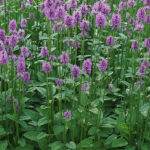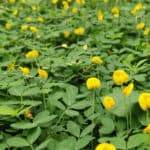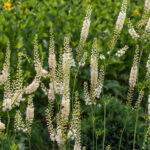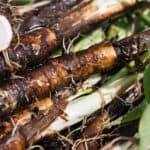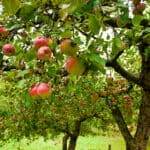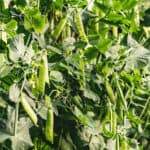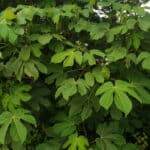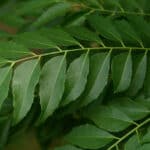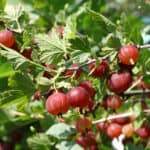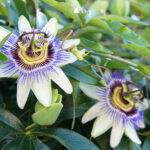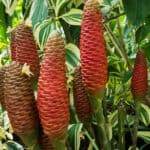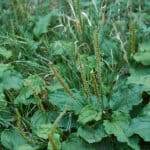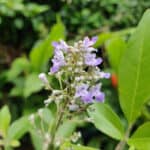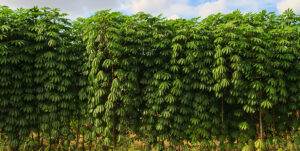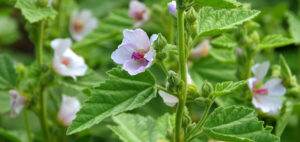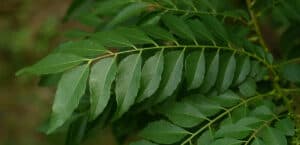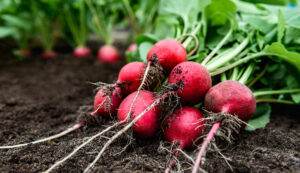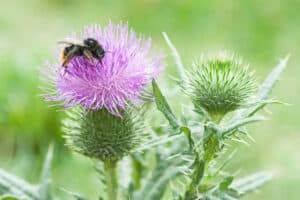Yarrow was one of the first wild medicinal plants I identified when I first began learning about herbs. I was on a hike in the Rocky Mountains of Colorado, around 10,000 elevation when my partner and I came across a meadow of yarrow and wild strawberries. Perhaps it was the vast wilderness tugging at my perception or the unbelievable taste of the strawberries lingering on my tongue. Still, there was something remarkable, ancient, and powerful about those swaying white-pink flowers. It ignited something deep and primitive within me, and that experience is forever imprinted in my mind. Since that moment, I’ve had a deep love and respect for yarrow, and I hope this growing guide inspires you to bring it into your garden and become familiar with its ancient, powerful ways.
Plant Overview
Perhaps yarrow instilled an ancient feeling within me because it’s an ancient remedy, the knowledge of its healing qualities passed down from generation to generation for over a millennia throughout the world. The farthest dating back record of its use is from two neanderthals, one in Iraq and one in Spain.
Yarrow, along with chamomile, was discovered in the teeth of a Neanderthal man excavated inside El Sidron Cave in northern Spain. His remains were found, along with 13 others, who formed a small neanderthal community dating back to between 47,300 and 50,600 years ago.
Another excavation in Iraq of a Neanderthal’s remains, named Shanidar IV, found that the man was buried with several pollen grains as if he was lain to rest on a bed of flowers. Many of those flowers were medicinal herbs, including yarrow, groundsel, and St. Barnaby’s Thistle. While there is debate on how and why the pollen grains were among this man’s remains, one author speculates he might have been a healer, as the other neanderthal remains around him did not have pollen grains surrounding them.
These archeological findings prove yarrow’s close association and reverence with mankind for as far back as we can find. Its scientific name, Achillea millefolium, also speaks to its historical popularity as a medicinal herb. Achillea is named after the demigod Achilles, who used yarrow to heal his wounds in the Iliad of Homer. Achilles was a pupil of the centaur Chiron, a powerful healer still revered as a spiritual archetype and asteroid in astrology.
Yarrow’s threads are woven into the tapestry of humanity. Through the lens of this significance, we can start to see the whole picture of its medicine and why it should be just as valuable today as it was then.
Plant Description
Achillea millefolium is an herbaceous perennial native to North America, Europe, and Asia. It is quite adaptive and can be found growing in sunny locations such as disturbed areas, meadows, pastures, grass balds, along roadsides, open mountains, and wider woods.
Before yarrow sends up its flowering stalk, its foliage grows as a basal rosette with soft, feathery, fern-like leaves. The leaves are about 2-6 inches long and are bipinnately, sometimes tripinnately, compound. As a spreading plant, it will grow in dense patches, forming soft and cushioned ground cover. When it begins to flower, it sends forth a stalk that can reach up to 3 feet tall. The leaves along the stem alternate, growing smaller and smaller as they ascend toward the flower.
Yarrow bears a creamy white and pink blushing inflorescence that forms a flat-topped corymb. As a member of the Asteraceae family, the corymb is made up of several small ray and disk florets that make the appearance of a single flower top. Both the leaves and flowers are highly aromatic, which is helpful when identifying them out in the field.
Yarrow’s appearance is somewhat similar to poison hemlock. As the name suggests, it is highly poisonous. Because of this, I recommend familiarizing yourself with the characteristics of poison hemlock before you harvest any wild yarrow.
Propagation and Planting
As an opportunistic plant, yarrow is incredibly easy to grow and will tolerate a variety of soil conditions. It can grow in zones 2-9 and prefers full sun to light shade. The soil pH range is 5.5-7 in fertile to poor soils with adequate drainage.
Yarrow is easy to start from seed and can be sown directly in the garden in the fall or early spring. Alternatively, start yarrow indoors in seed trays several weeks before the last frost date. As a light-dependent germinator, the seeds need to be sown on the surface of the soil and lightly tamped in, followed by gentle watering. Germination occurs in about 10-14 days.
As a spreading perennial, yarrow is a wonderful candidate for root division. This is some gardener’s method of choice when propagating yarrow, as it takes readily as a root division. Plus, if you wish to grow a yarrow cultivar, it will need to be propagated vegetatively to maintain its characteristic blooms.
Space or thin plants to 1 foot apart. Over the seasons, it will spread and create a dense mat of soft feathery leaves. Keep this in mind when selecting a spot for yarrow, as you’ll want to give it room to spread and do its thing. You can thin and control the patch through root division if your patch gets too dense or spreads too much. If you’d like, you can start another patch with the root division starts, give them away to friends, or thin out the plants and throw them in your compost or use them as green mulch.
Growth and Care
Yarrow will be happy in just about any spot as long as it receives good drainage and adequate sunlight. Once established, yarrow is sure to thrive, year after year. It will tolerate droughts, heat waves, frigid winters, and just about anything nature throws at it. A. millefolium is an incredibly hardy plant.
Interestingly, some herbalists recommend not to “pamper” your yarrow plants with fertile soil and frequent watering. This is because stressed plants produce more essential oil compounds, making the plant more viable for medicine. For this reason, some herbalists use wild yarrow flowers almost exclusively for medicine making, rather than the “pampered” garden flowers that don’t know the ruggedness of the wild. So, if you forget to water your yarrow plants now and then, it might be a good thing as you’re helping the flowers and leaves be more medicinally potent.
That said, yarrow grown in fertile, moist soil produces lush plants that bloom profusely. So, if you are more interested in the beauty, it will bring to your garden than its medicinal value, go ahead and give it all the love you want. Even with lower essential oil content, you’ll still receive healing medicine from your happy yarrow plants.
Garden Benefits
Yarrow’s beauty isn’t the only reason you’ll want to bring this medicinal herb into your garden. Yarrow offers several benefits as it’s a dynamic accumulator, a powerful companion plant, and attracts beneficial, predatory insects.
As a dynamic accumulator, its deep roots help break up compacted, dense soils while mining for nutrients such as phosphorous, potassium, and copper. This is why yarrow can thrive in a variety of soil conditions, as it can mine for the resources it needs. Those nutrients are then concentrated in the leaves, and once the leaves die and decompose, they release those nutrients back into the soil. This not only benefits yarrow as an herbaceous perennial but also benefits all the plants surrounding it.
While its roots are mining for nutrients, yarrow’s flowers benefit its close companions in another way. As mentioned, yarrow is quite fragrant due to its high essential oil profile. Those essential oils help distract and dissuade harmful pests and diseases, not only for yarrow itself but also for other plants in its proximity. This is why yarrow is called an “aromatic pest confuser,” a permaculture term used to describe plants that protect other plants by proximity. Amazingly, those same essential oils attract beneficial insects, such as ladybugs, lacewings, and hoverflies.
Pests and Diseases
Yarrow is not prone to pests or diseases thanks to its antimicrobial and pest-deterring volatile oil content. However, it could be susceptible to powdery mildew or botrytis mold depending on the area and climate it grows. These fungal diseases are probably more likely in humid, hot climates.
Possible Lawn Alternative?
Because of yarrow’s dense spreading habits, soft, feathery leaves, and thick root system, it is considered a suitable lawn alternative to grass. Moreover, its hardiness enables it to survive and rebound quickly from mowing and foot traffic.
One of the benefits of a yarrow lawn is that it’s drought tolerant, much more so than the grass species commonly used for lawns. In dry climates where water conservation is a concern, yarrow is a more sustainable option than grass.
The whole concept of a green manicured lawn is quite interesting. Grass is the number one watered crop in America. Read that again. We are using our precious water supplies on a crop purely for pleasure and its visual appearance.
Most lawn grass species are not native to North America. Many are native to Europe, Africa, or tropical/subtropical regions. Most of these climates are much different than the climates we have here in the United States, especially in the west. lawns in the United States need to be watered frequently for these non-native species to survive. Considering the drought occurring and the economic and environmental impact that a lawn has, I think it’s time to consider a grass alternative for our lawns, such as yarrow, native grass species, or an entirely new setup for our outdoor areas.
Okay, I’ll get off my soapbox and get back to the good stuff.
Harvesting
The flowers, leaves, and roots can all be harvested for medicine, however; the flowers and leaves are the common parts used in modern herbal medicine.
Harvest the leaves throughout the growing season as soon as they are lush and full of life. The leaves from the dense basal rosettes are preferred over the small leaves growing from the flowering stalk. However, both are suitable medicine.
Harvest the flowers once in full bloom. There’s this window of ‘vitality’ when yarrow flowers are bright and lush. When the flowers are in this stage, I harvest them for medicine; soon after all the little disc and ray florets fully open in the corymb. After a little while, the flowers will start to look less vibrant as they mature and form seeds. I don’t usually harvest the flowers once they start to have a dull look to them.
This is something I learned through experience, so I can’t verify the science behind it, but I believe when the flowers are at their brightest, their essential oil content is at its highest. More than that, it’s just an intuitive sense as to what flowers are ready for harvest and which ones aren’t. That intuitive sense is just as important as the knowledge of how and when to harvest.
Clip the flower heads near their base, or cut the stalks halfway down and hang them to dry (if you wish for both leaves and flowers). Scatter the flower heads on screens and dry them in a warm, dark place. If you use a dehydrator, set the temperature no higher than 95 degrees. Yarrow dries quickly, and its essential oils are easily lost in high heat. Or, prepare the fresh flowers and leaves as a tincture (1:2 or 1:3; 70%).
Medicinal Uses
Medicinal Actions:
- Astringent
- Vulnerary (styptic)
- Bitter tonic
- Circulatory stimulant
- Stimulant/relaxant diaphoretic
- Emmenagogue
- Hypotensive (lowers blood pressure)
- Diuretic
- Alterative
- Anti-inflammatory
- Anti-Septic
A whole article could be dedicated to yarrow’s medicinal uses. As you can see from its long list of actions, it’s a versatile remedy useful for many ailments. It’s also a fascinating medicinal plant, as it’s a paradoxical remedy that can balance conditions that are seemingly at odds with one another. As I continue to discuss its medicinal uses, you’ll come to understand what I mean.
Yarrow is one of the best first-aid remedies to become acquainted with, as it can staunch bleeding (styptic), heal wounds, and disinfect the area through its antiseptic properties. I’ve heard many first-hand experiences of herbalists who have used a fresh yarrow poultice out in the field when dealing with a bleeding injury, either for themselves or another. For more information on herbal first aid and how to care for a wound, check out this resource from herbalist 7song.
One of yarrow’s primary affinities is the blood/circulatory system. As mentioned, it has the ability to staunch bleeding, both internally and externally. It tones and tightens the blood vessels through its astringency within the veins and the peripheral capillaries. Interestingly, yarrow also can increase blood flow by opening up the blood vessels, allowing more blood to flow, which brings more nutrients and oxygen to the whole system. This is the perfect example of yarrow’s complex medicinal profile, as it can address the needs of the body and causes seemingly paradoxical effects on the circulatory system.
Herbalist Sajah Popham writes,
“As Yarrow is wonderful for toning the tissues, moving blood and improving the integrity of this venous circulation, conditions including varicose veins, hypotension, hypertension, thrombosis and any kind of cold/depression or damp stagnation within the body can be restored.”
In this same capacity, yarrow is used for the female reproductive system as an emmenagogue, which means it stimulates blood flow to the uterus. This is helpful for cramps and tension, as cramps are often a result of coldness and stagnation within the uterus. Yarrow helps to stimulate blood flow to the area, which releases tension and allows the blood to flow more freely; in turn, it eases menstrual cramps. However, it can also slow excess menstrual bleeding and tonify/tighten the tissues of the uterus. Again, we see that yarrow has the unique capacity to communicate with the wisdom of the body and offer healing support in whichever form is needed.
If you ever have yarrow as a tea or tincture, you’ll notice right away that it’s incredibly bitter. This bitterness is a wonderful aid to the digestive system. We have bitter receptors on our tongues, and as soon as we taste bitterness, those receptors send a message to the digestive system to start preparing for digestion and assimilation. Because it also has a strong affinity for the circulatory system, yarrow helps bring blood flow to the digestive system, which helps release stagnation and increases the assimilation of nutrients. In this way, yarrow can be used as a general digestive aid, as well as a specific remedy (in formulation) for diarrhea (through its astringency), leaky gut syndrome, dysbiosis, irritation of the intestines, and bacterial infections (antiseptic).
Another useful and common way to use yarrow is for fevers, and it is both a relaxing and stimulating diaphoretic in this capacity. A diaphoretic is an herb that induces sweating, which is what the body needs to do to support the process of a fever. Yarrow helps relax the blood vessels and stimulates the blood to flow up and away from the body’s core and out to the periphery. Amazingly, it also helps cool the blood once it reaches the periphery, and redirects that cooler blood back to the core. In this way, it is both warming and cooling to the system and is a highly effective fever remedy, especially in combination with Edler flowers and peppermint. Moreover, it also possesses anti-inflammatory and antimicrobial properties, which will aid in fighting the infection, whether it’s in the respiratory, digestive, or urinary system.
Yarrow also has an affinity for the urinary system as a diuretic, which means it encourages the excretion of fluids out through the urinary system (it makes you pee more). Because of its anti-inflammatory, astringent, and antimicrobial properties, it is a great herb to add in formulation for urinary tract infections, along with corn silk, uva-ursi, and marshmallow.
Through its ability to stimulate circulation, tighten and tonify the blood vessels, and expel the excess fluids of the body, yarrow is especially indicated for varicose veins and edema. It is also a wonderful treatment for hemorrhoids, both internally and externally.
I’ve only given you the tip of the iceberg when it comes to yarrow’s medicinal actions! There is so much more that I could go into, but I thought I would start with the most important elements of its medicine to help you get started. If you want to learn more about this valuable medicinal herb, I recommend checking out The School of Evolutionary Herbalism. Herbalist, Sajah Popham, offers a monthly subscription to his course, Materia Medica, where you can find an in-depth monograph on yarrow that goes into every nuance of this incredible herb.
Safety Profile
Yarrow is an overall gentle and safe remedy. However, as an emmenagogue, it’s not recommended during pregnancy.
Yarrow may decrease drug absorption due to increased gut motility. Because of this, it’s not recommended to take yarrow at the same time as other medications; rather, it’s best to wait a few hours.
As a member of the Asteraceae family, yarrow has the potential to cause an allergic reaction in people who are sensitive to members of this plant family.
Yarrow is an incredible herb with a lot to offer and would be a wonderful support for many people. That said, I would suggest speaking with a qualified herbalist before ingesting any herbal medicine to ensure it’s indicated for your needs and constitution.
Final Thoughts
I believe there is a reason yarrow has been with us for so long, thriving across the world and surviving as a prized herb over the millennium. There is no denying the intelligence and mysticism of this plant, as it can do what no other drug can: adjust its healing power according to the body’s needs.
There is something powerful, magical, and ancient residing in yarrow. I felt it that day in the wilderness of Colorado, and I sense it every time I gaze upon yarrow’s beautiful blooms and taste its distinct flavor on my tongue.
It is a protector of both humans and plants. You can see it in how it heals the body and how it defends its close neighbors with its fragrant, volatile oils. For this reason, I truly hope you bring it into the garden and discover its powerful healing nature for yourself.




